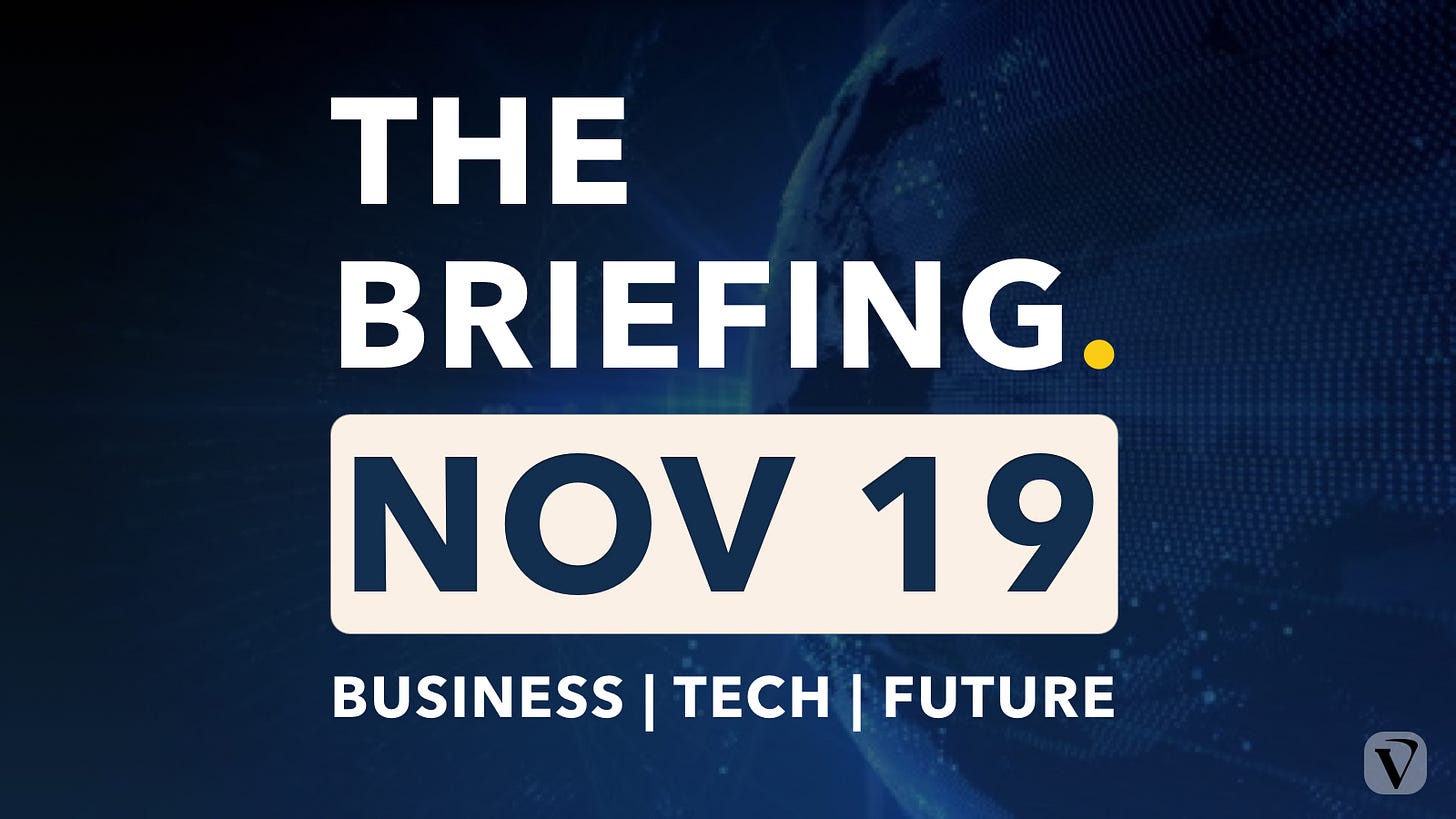The Briefing: AI Accelerates, The Cloud Cracks, Regulation Ramps
Issue #2025W47.3 / November 19 2025
Global markets experienced a fourth straight down day as investors began to voice the uncomfortable truth: AI valuations might be ahead of the underlying reality. The major US indexes slipped again on Tuesday, with the S&P 500 down and the Nasdaq declining, as money rotated out of high-flying AI names like Nvidia Corporation and other growth-heavy tech stocks. Meanwhile, bitcoin briefly fell under US$90,000, signalling weakening risk appetite.
At the same time, Google LLC launched its latest model, Gemini 3, directly embedding it into Google Search and the new internal development environment “Antigravity,” where AI agents can browse, code, and act on behalf of users. Google claims Gemini 3 Pro outperforms prior models in reasoning, multimodal tasks, and developer-focused benchmarks, with a “Deep Think” mode still to come. The fact that this is happening while valuations are being questioned is telling.
Meanwhile, IBM Corporation is publicly targeting “quantum advantage” by late 2026 and fault-tolerant quantum computing by 2029, highlighting that the technology capabilities curve is still accelerating even as speculative momentum cools. If you’re leading a business adopting AI, here’s the takeaway: momentum remains, but what matters now is the shift from experimentation to operational impact - workflows that reduce cost, unlock new value, or compress timelines by years.
The Internet Was Built to Survive Nukes. It Still Chokes on One Bug.
On Tuesday, a Cloudflare outage briefly broke a big chunk of the web, taking down or degrading access to services including X, ChatGPT, Canva, Grindr, and many others that depend on its edge network and security stack. Cloudflare says a “latent bug” triggered significant failures after unusual traffic at 11:20 UTC, generating error pages for users worldwide before a fix restored services.
This comes only weeks after a major AWS outage in October knocked thousands of apps and websites offline, including Signal, Roblox, banking platforms, and parts of government infrastructure.
The internet, originally developed by DARPA in the late 1960s as ARPANET to maintain communication even if parts of the network were destroyed, has since evolved into a highly centralised system dependent on a handful of major providers that now underpin most of the online ecosystem. Something increasingly voiced by experts globally.
Signal’s president Meredith Whittaker, addressed the criticism head-on after users discovered the supposedly “independent” messenger depends on AWS. Her argument in short: there is no realistic alternative if you need global scale and reliability. Only AWS, Azure, and Google Cloud can provide the infrastructure Signal needs, and building a separate stack would cost billions that nonprofits simply do not have. She warned that this concentration of power is the real problem, not the fact that Signal uses a cloud provider at all.
Critics, including long-time surveillance skeptic Edward Snowden, have spent years pointing out that centralizing data and computing with a few giants does not just create technical single points of failure. It also creates prime targets for state surveillance and commercial overreach, especially when those same firms control infrastructure and AI platforms.
Quiet Frontier Breakthroughs You Should Not Ignore
Not everything is about outages or market jitters. In fusion technology, the startup Zap Energy, Inc. announced its new device FuZE3 has reached gigapascal-level plasma pressures - the kind of regime necessary if fusion is ever going to compete with conventional power plants. At the same time European research alliance EUROfusion awarded grants to 23 researchers focused on next-gen reactor materials and simulations, signalling serious progress behind the scenes.
On batteries, US researchers demonstrated a sodium-ion pouch cell that operates reliably down to –100 °C and still pairs with real-world solar and wind systems. Since sodium is far more abundant than lithium, this could open cheaper, more flexible storage in climates and regions that were previously disadvantaged. Meanwhile, companies like Li‑S Energy, Inc. and NEO Battery Materials, Inc. secured fresh funding for lithium-sulfur and advanced LFP chemistries aimed at defense drones and AI-centred storage. The direction is shifting toward diverse battery chemistries, regional manufacturing, and supply-chain sovereignty.
In life sciences, gene therapies are evolving from bespoke “moonshots” into repeatable platforms. New patents such as those by Genprex, Inc. for its Reqorsa gene-therapy plus PD-L1-antibody combo - reinforce that the next generation of treatments is gearing toward scale. Scientists are partnering with regulators to accelerate custom gene therapies and base-editing pipelines so ultra-rare-disease treatments can be developed in weeks rather than years. The bottleneck is shifting from science to manufacturing and regulatory throughput. For the next decade, the constraint will be how fast we can make, deliver, and regulate treatments - not whether we can discover them. An exciting problem to have that opens up entirely new prospects of how we view health treatments.
In Other News
Waymo expanded fully driverless robotaxi operations in Miami and intends to launch in Dallas, Houston, San Antonio, and Orlando ahead of its full rollout in 2026.
Meta Platforms scored a major antitrust victory when a US court rejected the FTC’s attempt to force the divestiture of Instagram and WhatsApp, citing competition from TikTok, YouTube, and X.
Crypto exchange Kraken raised US$800 m at a US$20 bn valuation with a strategic stake from Citadel Securities, betting that regulated infrastructure will outlast token volatility.
A US government commission urged Congress to adopt a “Quantum First” goal by 2030, and firms such as NTT and OptQC announced plans to build optical quantum computers with one-million qubit targets by the end of the decade.
Chinese exports of batteries and grid-scale storage systems hit record highs while manufacturers in Australia and Mexico secured new investment — “energy-storage sovereignty” is becoming the next strategic manufacturing imperative.
Thank you for reading The Briefing — your nightly rundown of the key stories shaping business, technology, and innovation. If you like what you see, subscribe for free to receive the next editions in your inbox daily (Mon-Fri).



